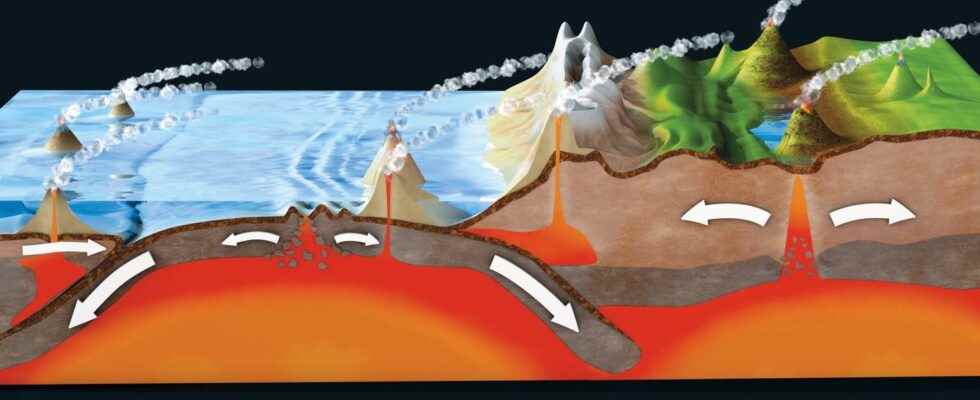“Slab” is the term used to refer to the sinking plate in the context of subduction. A subduction zone is defined by the convergence of two tectonic plates, with an oceanic plate passing under another plate (oceanic or continental). The top plate acts as a bumper, forcing the second plate to sink into the coat. The slab is thus defined as the portion of plate already engaged in subduction. In the case of a mature subduction zone, the weight exerted by the slab on the plunging plate is sufficient to maintain the subduction: it will in fact exert a pulling force which will drag the rest of the plate into a continuous descent of a few millimeters to a few centimeters per year. It is one of the drivers of plate tectonics.
Methods for imaging a slab in the mantle
It is possible to observe the slab within the mantle thanks to certain geophysical methods, especially seismology and the tomography seismic. Indeed, during its descent, the slab is characterized by significant seismicity along the Wadati-Benioff plane. small earthquakes are thus generated by the modification of the stresses applied to the slab throughout its descent within the mantle. They are very frequent down to a depth of around 100 kilometres, but some earthquakes can also occur at very great depth but more anecdotally. Earthquakes have thus been located on a slab at a depth of more than 600 kilometers, at the level of the interface between the upper mantle and the lower mantle. We do not yet understand what is the mechanism that allows the generation of earthquakes at such depth.
Slabs are also characterized by their relatively low temperature compared to the rest of the mantle into which they gradually sink. They can therefore be observed using seismic tomography, which studies and analyzes the speed of wave propagation. So the slab will be imaged as a high velocity anomaly within the mantle.
The presence of a deep slab influences the surface dynamics
These two techniques, analysis of wave speeds and analysis of hypocenters earthquakes, make it possible to define the position of the slab in relation to the subduction zone, and in particular to determine its inclination. The tilt of the slab, its dipis indeed highly variable from one subduction zone to another.
The dip of the slab will exert an influence on the dynamics of the upper plate. Indeed, when the slab has a strong dip, greater than 50°, this generates an extensive regime in the crust located vertically. We can thus see developing, behind the subduction zoneso-called back-arc basins that can go as far as the opening of a new ocean.
The presence of a deep slab will have several other consequences that will be expressed on the surface. One of the most visible effects of subducting a slab is certainly the generation of an intense volcanism. During its entry into subduction, the slab carries with it a large quantity of sediment heavily waterlogged oceans. The increase in pressure with the depth will “wring out” these sediments. The water will then migrate into the mantle overhanging the slab. L’hydration of these rocks will then lower their point of merger. From magma will thus form and rise through the crevices of the crust to give rise to a chain of volcanoes, located about 110 kilometers above the slab. These volcanoes have the particularity of being often explosive and of presenting lavas calc-alkaline, supersaturated in silica.
The presence of a slab will also lead to a modification of the isostatic balance of the upper plate. These changes are however more subtle and will be able to be observed by gravimetric or geodetic studies.
Major mineralogical changes along the descent
Slabs are capable of reaching great depths and reaching the lower mantle, or even the mantle-core interface. As they descend, the pressure-temperature conditions will cause major mineralogical changes. We are talking about metamorphism. The minerals which make up the rocks of the slab (mainly basalts, gabbros and peridotites) will thus find themselves in an unstable state and will evolve. We thus pass from a gabbro to a metagabbro of the facies shales green, then to a metagabbro of the facies blue shales, then to an eclogite. These transformations are accompanied by a dehydration mainly under the effect of the increase in pressure, the temperature increasing much less quickly. Eventually, the slab is entirely recycled and its minerals are going come to be added to those of the deep mantle.
You may also be interested
[EN VIDÉO] A billion years summarized in 40 seconds: plate tectonics Researchers have modeled the movements of tectonic plates over the past billion years.
Interested in what you just read?
